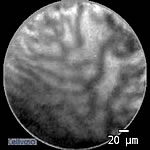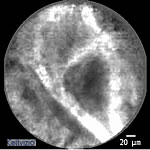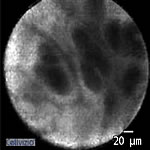|
CONFOCAL ENDOMICROSCOPY - CholangioFlex™ for Endoscopic Retrograde Cholangio-Pancreatography (ERCP) |
Characterize biliary strictures in real time
The CholangioFlex™ miniprobe allows direct, real-time microscopic level visualization of the bile duct epithelium during an Endoscopic Retrograde Cholangio-Pancreatography procedure (ERCP). This visualization of the bile duct in its finest details is a major step forward for ERCP, where traditional tools made it extremely difficult to obtain targeted histologic information to accurately characterize biliary strictures.
Going beyond tissue sampling limitations
ERCP-directed tissue sampling methods have been shown to be associated with low sensitivity (40-50%) for the past 4 decades, even when several methods are combined and used by experts.
 |
 |
 |
Endomicroscopic images of the bile duct showing different types of patterns: normal bile duct (left); abnormal vessels (center) and abnormal dark glands (right) indicative of cholangiocarcinoma, according to published work by Prof. Meining, Klinikum Rechts der Isar, Munich, Germany.
|
The cellular information obtained by probe-based Confocal Laser Endomicroscopy (pCLE) may be used during the procedure to target tissue sampling (brushings, biopsies or fine needle aspiration), after the procedure, to aid in documenting the clinical diagnosis and to add to the other clinically relevant parameters to assist in making treatment decisions on the spot.
Repeat ERCP procedures may be avoided by utilizing pCLE. See what physicians at University of Alabama at Brimingham or University of Virginia are saying about the use of pCLE in their practice.
A strong clinical validation with experts worldwide
Peer-reviewed publications of ERCP studies have shown that malignancies missed by conventional tissue sampling methods could be detected by the Cellvizio system, as proven by surgical specimen evaluation. In a first study at Klinikum Rechts der Isar in Munich, Prof. Alexander Meining and colleagues showed that Cellvizio® probe-based Confocal Laser Endomicroscopy (pCLE) increased the sensitivity of detection of cholangiocarcinoma to 83%.
The Cellvizio® ERCP Registry
From October 2008 to October 2009, 102 patients were enrolled in a prospective multi-centric, international registry called the "Cellvizio® ERCP registry" at leading institutions in the US and Europe in order to develop image interpretation criteria and generate sensitivity outcomes data when characterizing indeterminate strictures of the bile and pancreatic ducts when Cellvizio® is added to the standard ERCP.
Interim results of the Cellvizio® ERCP Registry were presented in 2 important oral presentations by Prof. Yang Chen (University of Colorado Hospital), principal investigator of the study, at the United European Gastroenterology Week 2009 (UEGW) 2009 conference in London and at the Digestive Disease Week 2010 (DDW) conference in New Orleans.
The study showed that Cellvizio® considerably improved the detection sensitivity of malignant strictures by detecting 98% of malignant patients in real-time during ERCP with a negative predictive value of 97% (diagnosis confirmed by pathology or by a one-year follow-up in the case of benign stricture).
Results from another single-center study on more than 30 patients from Dr Giovannini and colleagues at the leading cancer center Institut Paoli-Calmettes in Marseilles, France, were also presented at DDW 2010 and confirmed a sensitivity of detection of cholangiocarcinoma of 83%, a major improvement over biopsies (53%).
|
MORE
• GastroFlex™ UHD for Eso-Gastro-Duodenoscopy (EGD)
• CholangioFlex™ for Endoscopic Retrograde Cholangio-Pancreatography (ERCP)
• AQ-Flex™ 19 for Endoscopic Ultrasound-Guided Fine Needle Aspiration (EUS-FNA)
• ColoFlex™ UHD for Colonoscopy
• AlveoFlex™ for Bronchoscopy and Alveoscopy
|
TO ORDER THIS PRODUCT, or "REQUEST A DEMO" or need MORE INFORMATION"
CONTACT SALES NOW
|
| PDF DOWNLOADS |
 Cellvizio® Bibliography Cellvizio® Bibliography
 CholangioFlex™ Application note 1 CholangioFlex™ Application note 1
|
| DEMONSTRATION VIDEOS |
 Click here to view videos of this product - Note: all now discontinued products Click here to view videos of this product - Note: all now discontinued products
 Click here to visit the SynMed Channel Click here to visit the SynMed Channel
|
| LINKS & MORE INFORMATION |
 Click here to find out about out frequent and high-quality training opportunities Click here to find out about out frequent and high-quality training opportunities
 Click here to find out about the International Conference of Cellvizio Users Click here to find out about the International Conference of Cellvizio Users
 Click here to find out about www.cellvizio.net: a complete e-learning center for Cellvizio users Click here to find out about www.cellvizio.net: a complete e-learning center for Cellvizio users
|
|

